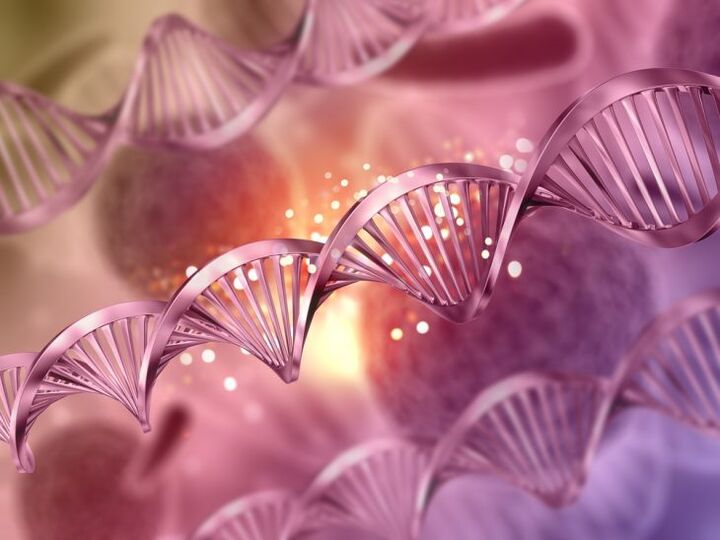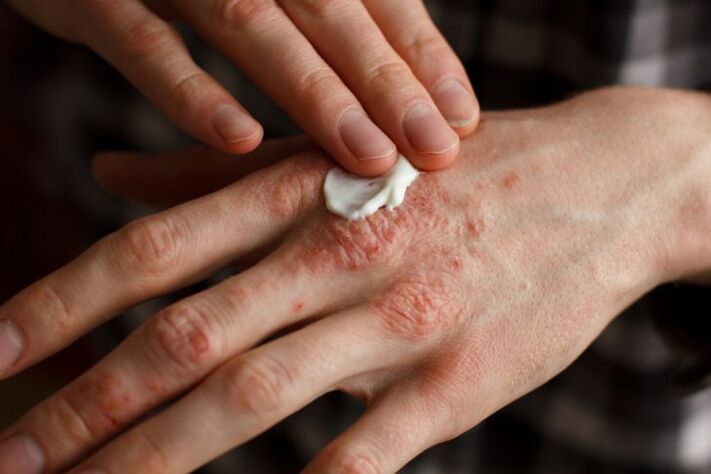Psoriasis or squamous lichen in children is a chronic disease characterized by the formation of silvery white papules (lumps) on the skin of children. The incidence of psoriasis among all skin diseases is about 8%. This disease occurs in groups of children of different ages, including infants and newborns, and is more common in girls. The disease has certain seasonal characteristics: there are more cases of psoriasis in winter than in summer.
This disease is not contagious, although the viral theory of its origin is still under consideration.
Cause

The normal maturation cycle of skin cells is 30 days. In psoriasis, it can be shortened to 4-5 days, manifested by the formation of psoriasis plaques. Through electron microscopy, it was found that children’s healthy skin had the same changes as the affected area. In addition, the functions of the nerves, endocrine, immune system, metabolism (mainly enzymes and fats) and other body changes of psoriasis patients are damaged. This indicates that psoriasis is a systemic disease.
There are three main causes of psoriasis:
- Genetic
- Wednesday;
- Infect.
Heredity is the main factor in the development of psoriasis. Studies on skin diseases that occur in twins, generations of relatives, and biochemical studies on healthy family members confirm this. If one parent is sick, the probability of the child getting psoriasis is 25%, and if both parents are sick, it is 60-75%. At the same time, the genetic type is still unclear and is considered to be multifactorial.
Environmental factors include seasonal changes, clothing and skin contact, the impact of stress on children's psychology, and the relationship with peers. Focus the attention of the children in the team on the sick children, treat them as "black sheep" and restrict contact for fear of being infected-all these factors will trigger new deterioration and increase the area of skin lesions. Due to hormonal changes, adolescent children are particularly vulnerable. Therefore, a large part of the detection of the disease falls on adolescents.
The proportions of genetic and environmental factors that induce the onset of psoriasis are 65% and 35%, respectively.
Infection triggers the infectious allergic reaction mechanism, which triggers the development of psoriasis. Therefore, influenza, pneumonia, pyelonephritis, and hepatitis can occur after the infection of this disease. Even the post-infection form of the disease is different. It is characterized by a large number of drop-shaped papules all over the body.
In some cases, the onset of psoriasis precedes skin trauma.
symptom
Psoriasis is characterized by a rash in the form of small red islands ("plaques") on the skin with silvery white patches that are prone to peeling and itching. Cracks in the plaque may be accompanied by minor bleeding and secondary infection.
On the surface, the psoriasis rash in children is similar to that in adults, but there are some differences. For children with psoriasis, Koebner syndrome is very characteristic-a rash in the area affected by irritation or injury.
The course of psoriasis in children is very long, except for the teardrop-shaped, more favorable form of the disease. The disease is divided into three stages:
- Progress;
- stationary;
- fall back.
The progressive stage is characterized by the formation of small itchy papules surrounded by red edges. Lymph nodes may enlarge and thicken, especially in severe psoriasis. During the resting period, the rash stops growing, the center of the plaque becomes flat, and scaling is reduced. In the degenerative stage, the components of the rash dissolve, leaving a discolored edge (Voronov edge). The rash can leave spots with hyperpigmentation or hypopigmentation.
The location of the psoriasis rash may be different. In most cases, the skin of the elbows, knees, buttocks, belly button, and scalp will be affected. Every one-third of children with psoriasis have nails affected (the so-called thimble symptom, that is, small holes appear on the nail plate, similar to the thimble nest). Plaques can usually be found in the folds of the skin. The mucous membranes, especially the tongue, can also be affected, and the rash can change its position and shape ("geographic tongue"). The palm skin and plantar surface are characterized by hyperkeratosis (thickening of the upper layer of the epidermis). The face is unlikely to be affected. The rash appears on the forehead and cheeks and may spread to the ears.
In blood analysis, an increase in total protein and gamma globulin levels, a decrease in albumin-globulin coefficient, and a disorder of fat metabolism were detected.
Forms of psoriasis in children
- Drop shape
- plaque;
- Pustules
- Erythroderma;
- Infant psoriasis;
- Psoriatic arthritis.
The most common form isTeardrop psoriasis. . . It manifests as red lumps on the body and limbs, which occur after minor injuries and after infection (otitis media, nasopharyngitis, flu, etc. ). In the throat swab, cytology showed streptococcus. Teardrop psoriasis is often confused with allergic reactions.
Plaque psoriasis is characterized by a well-defined red rash and a thick layer of white scales.
Pustules or pustular forms of this disease are rare. The appearance of pustules can be caused by infection, vaccination, the use of certain drugs, and stress. Pustular psoriasis that occurs in newborns is called newborns.
With erythroderma-type psoriasis, the child's skin looks completely red; certain areas of the skin may have patches. Usually, skin manifestations are accompanied by increased body temperature and joint pain.
Pustular and erythrodermic psoriasis can take systemic forms with a severe course. They need to be hospitalized to avoid death.
Infant psoriasis is also called diaper psoriasis. Since skin damage most often occurs in the buttocks area and may be mistaken for skin diseases due to the irritation of urine and feces to the skin, it is difficult to diagnose.
Psoriatic arthritis affects approximately 10% of children with psoriasis. The joints are swollen, the muscles become stiff, and the toes, ankles, knees, and wrists are painful. Conjunctivitis is often associated with this.
Generally, the course of any form of disease changes every three months. In summer, the symptoms usually subside due to sun exposure.
treat

Children who have psoriasis for the first time are best hospitalized.
- Prescribe desensitizers (containing 5% calcium gluconate solution or 10% calcium chloride solution, intramuscular injection of 10% calcium gluconate solution) and tranquilizers (leonurus tincture, valerian).
- People with severe itching should take antihistamines and tranquilizers.
- B vitamins intramuscular injection 10-20 times: B6 (pyridoxine), B12 (cyanocobalamin), B2 (riboflavin); internal: B15 (pantothenic acid), B9 (folic acid), A (retinol) andC (Ascorbic acid).
- In order to activate the body's defenses, drugs with heat-generating (warming) properties are used. They normalize vascular permeability and reduce the rate of epidermal cell division.
- Shows weekly blood transfusion, introduction of plasma and albumin.
- If the treatment is ineffective and the condition is severe, the doctor can prescribe glucocorticoids within a course of 2-3 weeks, gradually reduce the dose and then stop the medication. The dosage is selected individually. Due to its toxicity, cytostatics are not suitable for children.
- To combat plaque on the palms and soles, use a closed (sealed) dressing with salicylic acid sulfur tar ointment.
- During the resting and regressive stages of psoriasis, children will be prescribed UFOs, sedative baths, and herbal medicine. The sapropel extract has been proven to be used in the form of an application or bath.
Psoriasis is accompanied by frequent colds and it is necessary to disinfect the source of infection: treatment of caries, deworming, and if necessary, tonsillectomy and glandectomy. An ideal step to treat psoriasis is hydrotherapy.
It must be remembered that psoriasis is a chronic disease, characterized by an exacerbation period and a remission period, and it is necessary to prepare for long-term regular treatment.
The child needs to instill a healthy lifestyle, teach him to cope with pressure and calmly deal with peer attacks. The situation is especially difficult for children whose facial skin is affected. All family members should support the sick child, which will help him avoid complexity and grow into a person who adapts to society.
Which doctor to contact
Psoriasis in children is treated by a dermatologist. If not only the skin is affected, but the joints are also affected, you need to consult a rheumatologist, accompanied by the development of conjunctivitis-an ophthalmologist. It is necessary to see a dentist, infectious disease specialist, and otolaryngologist to disinfect the chronically infected lesions. If the differential diagnosis of psoriasis and allergic diseases is difficult, you should contact an allergy specialist. Nutritionists, physiotherapists and psychologists assist in treating patients.























